Optical imaging lens
a technology of optical imaging and lens system, applied in the field of optical elements, can solve the problems of mobile phones and digital cameras being miniaturized, and achieve the effects of reducing the length of the lens system, and reducing the field of view
- Summary
- Abstract
- Description
- Claims
- Application Information
AI Technical Summary
Benefits of technology
Problems solved by technology
Method used
Image
Examples
first embodiment
[0090]Besides, the relations between the various important parameters of the optical imaging lens 10 of the first embodiment are as shown in FIG. 54.
Here,
[0091]V1 represents the Abbe number of the first lens element 3;[0092]V2 represents the Abbe number of the second lens element 4;[0093]V3 represents the Abbe number of the third lens element 5;[0094]V4 represents the Abbe number of the fourth lens element 6;[0095]V5 represents the Abbe number of the fifth lens element 7;[0096]V6 represents the Abbe number of the sixth lens element 8;[0097]T1 represents the thickness of the first lens element 3 on the optical axis I;[0098]T2 represents the thickness of the second lens element 4 on the optical axis I;[0099]T3 represents the thickness of the third lens element 5 on the optical axis I;[0100]T4 represents the thickness of the fourth lens element 6 on the optical axis I;[0101]T5 represents the thickness of the fifth lens element 7 on the optical axis I;[0102]T6 represents the thickness o...
second embodiment
[0120]The respective aspheric surface coefficients of the object-side surface 31 of the first lens element 3 to the image-side surface 82 of the sixth lens element 8 of the second embodiment in Formula (1) are as shown in FIG. 13.
[0121]Besides, the relations between the various important parameters of the optical imaging lens 10 of the second embodiment are as shown in FIG. 54.
[0122]The diagram of the longitudinal spherical aberration of the second embodiment as shown in FIG. 11A simulates the condition when the pupil radius is 1.1449 mm. In the diagram of the longitudinal spherical aberration of the second embodiment as shown in FIG. 11A, the image point deviations of the off-axis rays at different heights are controlled within ±0.018 mm. In the diagrams of the field curvature aberrations as shown in FIGS. 11B and 11C, the focal length variations of the representing wavelengths within the whole range of the field of view are within ±0.07 mm. Besides, the diagram of the distortion a...
third embodiment
[0126]The respective aspheric surface coefficients of the object-side surface 31 of the first lens element 3 to the image-side surface 82 of the sixth lens element 8 of the third embodiment in Formula (1) are as shown in FIG. 17.
[0127]Besides, the relations between the various important parameters of the optical imaging lens 10 of the third embodiment are as shown in FIG. 54.
[0128]The diagram of the longitudinal spherical aberration of the third embodiment as shown in FIG. 15A simulates the condition when the pupil radius is 1.1262 mm. In the diagram of the longitudinal spherical aberration of the third embodiment as shown in FIG. 15A, the image point deviations of the off-axis rays at different heights are controlled within ±0.02 mm. In the diagrams of the field curvature aberrations as shown in FIGS. 15B and 15C, the focal length variations of the representing wavelengths within the whole range of the field of view are within ±0.45 mm. Besides, the diagram of the distortion aberra...
PUM
 Login to View More
Login to View More Abstract
Description
Claims
Application Information
 Login to View More
Login to View More - R&D
- Intellectual Property
- Life Sciences
- Materials
- Tech Scout
- Unparalleled Data Quality
- Higher Quality Content
- 60% Fewer Hallucinations
Browse by: Latest US Patents, China's latest patents, Technical Efficacy Thesaurus, Application Domain, Technology Topic, Popular Technical Reports.
© 2025 PatSnap. All rights reserved.Legal|Privacy policy|Modern Slavery Act Transparency Statement|Sitemap|About US| Contact US: help@patsnap.com



